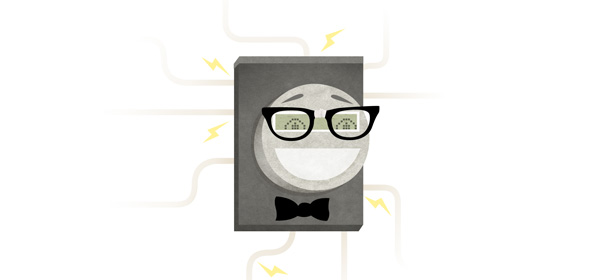Story by Samantha Wittchen | Illustration by Melissa McFeeters
Over the past several years, smart grid technology has been held up as a way to achieve energy independence, combat global warming and improve grid reliability. Who could be against that? But for most consumers, the smart grid is a nebulous, monolithic technological advancement that has little relevance to their everyday lives. It’s hard for consumers to see how they’ll be able to take advantage of this intelligent network because large utility companies that currently control the electric grid dictate how and when consumers will begin to interact with it. This month, we demystify it.
As per smartgrid.gov, the smart grid is “an automated electric power system that monitors and controls grid activities, ensuring the two-way flow of electricity and information between power plants and consumers.” In other words, the smart grid enables you to “talk back” to the electric company and tell it about your usage habits. This allows the electric company to optimize how and when it generates electricity so that it’s more efficient, more stable, and ideally, cheaper. The smart grid is enabled by information technologies that measure billions of data points from consumers and other system devices that monitor daily how the system runs.
As a single consumer, you can’t “install” a smart grid. But you can help pave the way by taking advantage of “smart meters” that replace traditional electric meters. Unfortunately, you can’t pick up a smart meter at Home Depot. You have to wait until your utility company provides one to you, but it’s well worth asking about having one installed. Smart meters allow you to monitor your energy consumption in real time, as opposed to sitting back and waiting for a bill. Google has developed a dashboard tool called PowerMeter (google.com/powermeter) that integrates with smart meters so you can monitor your home’s energy consumption online. Several manufacturers will start offering dashboards that can be mounted on the wall in your home. Companies such as GE are developing smart appliances that tie into smart meters to help consumers shift their electrical consumption—such as running a clothes dryer—to off-peak periods.
Smart meters communicate back to power plants and help them optimize their systems, eliminating the guesswork inherent in predicting the amount of electricity that will be needed at any given time of day. In some cases, it could mean the difference between bringing older, less efficient plants online to accommodate peak demand and leaving them shut down. That’s a huge win for the environment.
Once electric companies start offering incentives—like preferential pricing—for using energy at off-peak periods, smart grid technologies will save you money. It looks like PECO is headed in that incentive-based direction. The company expects to roll out smart metering technology in early 2012, and thanks to a $200 million stimulus grant from the federal government, they’ll be expanding the number of meters initially installed from 100,000 to 600,000.
This is all good news for Philadelphians. While the technology may not be available for another year, there’s no time like the present to start bugging PECO (800-494-4000) about whether your home can be one of the 600,000 that’s plugged into the smart grid.
For more about PECO’s smart meter pilot program, visit peco.com/aboutpeco/smartmeterssmartfuture.
Samantha Wittchen is partner and co-founder of iSpring (ispringassociates), a sustainability consulting firm serving companies and organizations in the Delaware and Lehigh valleys.




